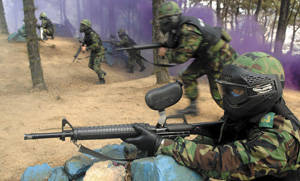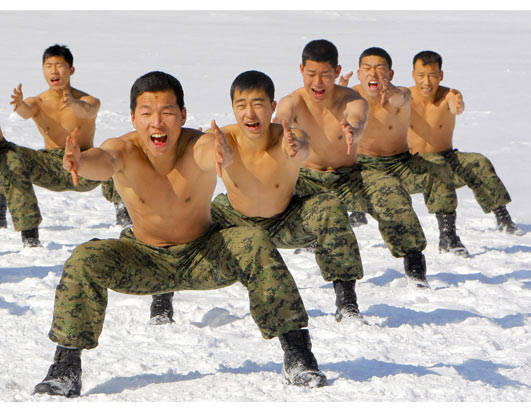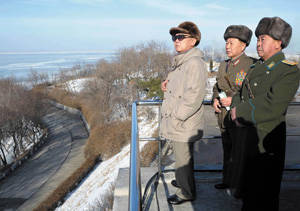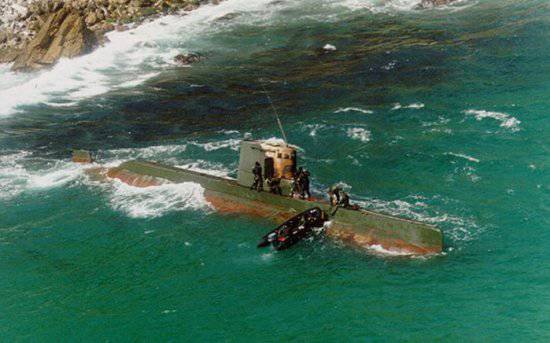If tomorrow is war ... Second Korean
 The regular aggravation of relations between Seoul and Pyongyang once again raised fears about the possibility of a new war on the Korean Peninsula. Moreover, in the capital of capitalist Korea, they declared their readiness to deliver a preemptive strike on socialist Korea, if it becomes obvious that the DPRK is preparing to attack a state located south of the 38 parallel. Of course, in Pyongyang, by tradition, they promised monstrous retaliation to "American puppets."
The regular aggravation of relations between Seoul and Pyongyang once again raised fears about the possibility of a new war on the Korean Peninsula. Moreover, in the capital of capitalist Korea, they declared their readiness to deliver a preemptive strike on socialist Korea, if it becomes obvious that the DPRK is preparing to attack a state located south of the 38 parallel. Of course, in Pyongyang, by tradition, they promised monstrous retaliation to "American puppets." STALEMATE SITUATION
In fact, armed conflicts, similar to those that occurred last week, occur regularly between the Republic of Korea and the DPRK, have become accustomed to them, but because of the complete unpredictability of the North Korean regime (at least external), each such “fire contact” is expected growing into a massive force confrontation. It should be noted that from time to time the fighting at sea also unfolds, sometimes even with casualties.
So, in April 1999, the DPRK Navy lost a torpedo boat, in June, 2002-th they took revenge, sinking the South Korean patrol boat. This, however, did not lead to a "big" war.
In fact, neither Seoul, nor Pyongyang (and neither Washington, nor Beijing) need it at all. But there is such a phenomenon as an uncontrolled escalation that can bring to war even against the will of the parties. The most striking example of this development was the summer of 1914, when the First World War, which killed European civilization, broke out. Therefore, the “second Korean” scenario is of considerable interest.
Both Koreas possess huge and very powerful armed forces. The DPRK ranks first in the world in terms of the number of military personnel per capita (1,11 million people with 24,5 million inhabitants; the mobilization reserve numbering 4,7 million people already in peacetime was selected by almost 40%). Duration of military service: 5 – 8 years - in the Army, 3 – 4 of the year - in the Air Force, 5 – 10 years - in the Navy. In terms of the share of military expenditures in GDP (about 15%), North Korea is in second place on the planet after Eritrea, although in absolute terms this figure is small (an order of magnitude less than the Republic of Korea, and two less than the US).
The South Korean armed forces (about 700 thousand people) are inferior in the strength of the DPRK Armed Forces, but this is offset by technological superiority. The Republic of Korea, as you know, has managed to become one of the most economically developed countries in the world. This factor, as well as close cooperation with the United States, allowed Seoul to maintain a well-equipped army, Aviation and the fleet, to create a very strong defense industry capable of producing weapon and military equipment of almost all classes, and almost as good as the best world models.
North Korea has a significant superiority in the number of armaments and military equipment of the ground forces, and it ranks third in the world after China and Russia in the number of artillery barrels (up to 20 thousand guns, mortars and MLRS). True, all samples of weapons and military equipment are either Soviet 1960 – 1970s, or their Chinese and local copies, as well as alterations. By the number of modern samples, the advantage is on the side of South Korea.
The combat aircraft at the disposal of Pyongyang and Seoul are approximately equal in number (in 600 units), but as for the relatively new machines, there is an overwhelming superiority among the southerners (one and a half hundred F-16 and 40 F-15 against two dozen MiG-29).
By the number of submarines, the northerners have an advantage so far, but of high quality, again on the southerners' side (the latest German submarines versus very old Soviet submarines). However, the northerners have several dozen small submarines for sabotage operations. In large surface ships, the superiority of the Republic of Korea over the DPRK (both quantitative and qualitative) is so great that there is no way to compare. But the North Korean Navy has significantly more combat and landing boats, which, given the hydrographic conditions favorable to the actions of light forces, will create significant tension for the South Korean in case of war fleet.
The moral and psychological preparation of the personnel of the armed forces of the parties seems to be at about the same level. Yes, and the level of combat training among the southerners, although most likely, is higher, but not by much. On the whole, the Armed Forces of the Republic of Kazakhstan are fully capable of successfully defending their country, but it is unlikely that they will be able to complete the task of completely defeating the North Korean army and seizing the territory of the DPRK. The reverse is also true. In fact, a situation of “strategic stalemate” exists between the two states, when neither of the parties is able to bring the enemy to their knees. Neither the qualitative superiority of the southerners, nor the quantitative superiority of the northerners is enough for a decisive victory with the complete capture of the enemy's territory.

Of course, the situation is changing with the joint operations of the armed forces of the Republic of Korea and the United States, since the enormous American technical capabilities must ultimately ensure the success of the coalition. However, one can not fail to mention a number of nuances that greatly change the whole picture.
THIS IS NOT YOU IRAQ
The fighting qualities of soldiers from East Asian countries are traditionally very high, by this indicator they are quite comparable with the soldiers of the best European armies and are an order of magnitude superior to colleagues from Middle Eastern countries (with the exception of Israel). In the case of the DPRK, this factor is aggravated by the total propaganda continuing for more than half a century, combined with the absolute closeness of North Korean society. Thus, we should not expect a repetition of the Iraqi scenario 2003 of the year, when, after a short resistance, part of Saddam’s generals was sold, and most of the military, including the “elite” Republican Guard, simply went home. The DPRK army will fight with fanatical perseverance, while the level of military training of Koreans is much higher than that of the Arabs.
Another characteristic feature of the East Asian armies in general and the North Korean army in particular is absolute insensitivity to their own losses, that is, resistance will continue literally "until the last drop of blood." At the same time, mass suicide bombing is possible on land, at sea and in the air. They will undermine armored vehicles, ships in the coastal zone (they will deliver sea suicide bombers to the target of boats and submarines, first of all ultra-small ones), the most outdated combat aircraft, more traditional applications of which have no chance of success, can be used as kamikazes. The experience of the Japanese kamikazes at the end of the Second World War showed that they are much more effective than “normal” aircraft.
The most important feature of warfare by the North Korean army will be the maximum use of geographical conditions. It can be said that the DPRK by nature itself is ideally suited for defense. Almost 75% of the country is covered by mountains. They are not only natural defensive lines that make it extremely difficult to use both ground-based equipment and offensive aviation, but also natural shelter for troops and industrial facilities.
In addition, immediately after the end of the 1950 – 1953 war in DPRK, mass construction of tunnels and shelters began, the depth of which reaches 80 – 100 m. The defeat of such objects not only with conventional weapons, including high-precision weapons, but also with low and medium power nuclear weapons difficult. Only a direct hit at the entrance of a tunnel can be effective; however, in order to reach it, one must know, first, its exact place, second, the number of such inputs (as a rule, there are more than one). And they, meanwhile, are perfectly camouflaged, often located in “dead zones” for aviation weapons.
In such tunnels, natural and artificial caves are capable of hiding large military units, including armored vehicles, as well as defense and nuclear facilities. Through the use of underground shelters, a disarming air strike against the DPRK becomes extremely difficult, if not impossible.
Underground shelters and tunnels can be used by North Koreans not only for defense, but also for an offensive. A significant number of such tunnels several tens of meters wide (which ensures the passage of armored vehicles through them) in peacetime have been dug under the demarcation line on the 38 parallel and has disguised exits on the territory of the Republic of Korea. With their help, it is supposed to strike a sudden blow to the rear of the South Korean and American troops located in the border zone. Some of these tunnels were discovered and destroyed by the South Korean army, but their total number is unknown.
The peculiarities of the DPRK sea coast extremely complicate the landing of amphibious assault forces. Small depths and complex fairways contribute to the widespread and successful use of mine weapons, and the mountainous coast greatly complicates the use of ground-based landing techniques, but it allows you to build a large number of well-camouflaged coastal artillery and rocket batteries, which are covered with air defense weapons. This creates a situation where mine-sweeping forces that provide landing cannot act until complete suppression of coastal batteries, artillery support of minesweepers from cruisers and destroyers is impossible due to the mine threat, and the suppression of coastal batteries by air strikes is difficult because of their location in well-camouflaged and protected rock shelters and due to opposition to air defenses.
In this regard, we can recall the experience of the 1950 – 1953 war, at the initial stage of which the US Navy carried out two large landing operations. The first of them, Incheon, which was held in the second half of September 1950, was successful, it made a turn in the course of the war. However, this success was due to the fact that the South Korean port of Incheon was, firstly, convenient for landing from a geographical point of view, and secondly, it was practically not prepared for defense, since the North Korean troops seized it only 1,5 a month before the onset of the Americans.
But the second operation, Wonsan, completely failed in October 1950. The US Navy and its allies never managed to overcome the northerners ’mine and artillery positions that had been established in advance, losing four minesweepers (two American and two South Korean) in one day of October. Wonsan was captured by American troops advancing on land, but even after that, the landing craft for nearly two weeks could not enter the port.
There is no doubt: over the past 50 years, the DPRK's Armed Forces have prepared very well for antiamphibious defense in all possible landing sites.
North Korean leader Kim Jong Il with his warlords.
CATASTROPHE FOR EVERYONE, EXCEPT BEIJAN
 Active guerrilla operations will unfold on the territory occupied by the American and South Korean forces, and the system of underground shelters will allow whole North Korean units to use guerrilla tactics, suddenly appearing in the rear of the enemy and acting on the “strike-retreat” principle. Northerners have significant potential for actions of this nature. Their ground forces have 10 sniper brigades (there are no such units in any other army in the world) and the command of special forces of the DPRK armed forces, which have 12 light infantry brigades (including three marines), 17 reconnaissance battalions and 8 battalions special forces.
Active guerrilla operations will unfold on the territory occupied by the American and South Korean forces, and the system of underground shelters will allow whole North Korean units to use guerrilla tactics, suddenly appearing in the rear of the enemy and acting on the “strike-retreat” principle. Northerners have significant potential for actions of this nature. Their ground forces have 10 sniper brigades (there are no such units in any other army in the world) and the command of special forces of the DPRK armed forces, which have 12 light infantry brigades (including three marines), 17 reconnaissance battalions and 8 battalions special forces. Even if the North Korean air forces die in the first days of the war, DPRK ground defense systems will create permanent problems for the air force and especially for enemy enemy aircraft (it is impossible to completely suppress MANPADS and anti-aircraft artillery even theoretically, and the DPRK has up to 10 thousand portable anti-aircraft guns and at least 11 thousand anti-aircraft guns). In addition, the use of underground shelters by North Korean troops will largely devalue the domination of American and South Korean aircraft in the air: it will not be physically able to respond to every enemy appearance in the literal sense out of the ground. Therefore, even with the most favorable development of events for the US-South Korean forces, the rate of losses will be at least an order of magnitude higher than that of the Americans and the British during the last war in Iraq, and the duration of the campaign will certainly be several months. Thus, the United States is guaranteed the loss of at least several thousand people only killed (for several months, not years, as in Iraq), and in the worst case the score will go to tens of thousands.
At the same time, the American group stationed in South Korea (1 division, 1 army aviation brigade, 4 air force squadrons, more than 100 tanks, about 250 infantry fighting vehicles and armored personnel carriers, about 50 artillery systems, about 100 combat aircraft), it’s absolutely not enough to conduct a full-scale war against the DPRK. Moreover, there will not be enough other forces permanently stationed on the Pacific theater of operations - the 3rd Marine Corps Division and five fighter squadrons (about 100 more aircraft) located in Japan, as well as the 25th Light Infantry Division and one National Guard Air Force squadron (18 F-15 fighters) - in Hawaii (especially since the transfer of ground troops from the Hawaiian Islands to Korea takes at least a month).
In addition, without the Korean War, the United States is experiencing a huge over-exertion of forces due to the simultaneous campaigning in Iraq and Afghanistan. Accordingly, Washington, especially under the current pacifist president, will do everything to prevent a large-scale armed conflict on the Korean Peninsula. If it does begin, the situation for the United States will be almost catastrophic.
In order to seriously help the southerners, America will have to restore the draft principle of manning the armed forces. But it is clear that this is completely excluded for political reasons. In addition, in the States it is not customary to send untrained "cannon fodder" into battle, recruits in any case will have to be trained on their territory for at least a year. Therefore, apparently, the United States will have to throw into battle almost all combat aircraft, including carrier-based aircraft. True, there will be a problem with the capacity of the airfield network of the Republic of Korea. And it’s not a fact that Japan will necessarily provide its airfields for the Americans, especially at the current premiere, which clearly demonstrates a course that is as independent as possible from Washington. For aircraft carriers there will be another problem - the time of transition to the Korean coast.
Recently, in the USA, many-tonnes (over 10 tons) bombs are being actively developed, specifically designed for the destruction of underground structures. It is clear that they are being prepared for possible wars against Iran and the DPRK. It is difficult to say how effective they will be. Moreover, before you hit a ground target, it still needs to be detected. It is not known what is more difficult. In addition, a significant constraint on the use of multi-ton bombs is the factor that their carriers can only be strategic bombers, which the US Air Force has only a hundred and fifty, including B-1.
The situation will be significantly aggravated if the DPRK does have nuclear weapons (this is not yet completely obvious). Even if the northerners have only stationary devices (nuclear land mines), they will use them against the attacking troops of the United States and Kazakhstan, causing them enormous losses, as well as creating rubble in the mountains and zones of continuous radioactive contamination. If, in North Korea, nuclear warheads are created for missiles and bombs for airplanes (the second is much simpler), then they will be able to strike at various military and industrial facilities in South Korea (including, of course, American forces), as well as US naval groupings off the coast of the Korean Peninsula. The losses of troops and civilians in this case will amount to hundreds of thousands, if not millions of people; the environmental consequences for the Asia-Pacific region (including our Far East) are unpredictable. After that, any victory over the DPRK will be truly Pyrrhic.
We can not say about the role of China, which is likely to be decisive. For Beijing, the war (especially nuclear) at its borders (and not far enough from the capital) is completely unnecessary. But the American troops on their border are not needed all the more.
Relations between the DPRK and the PRC are very complicated. Pyongyang is not in any way a Chinese puppet, although it is very much dependent on Beijing economically. In the Celestial Empire, the Juche followers are treated as ungrateful people (after all, it was Chinese troops who saved the DPRK during the first Korean), if not as traitors. In the DPRK, the Chinese see (and not without reason) potential occupiers. Beijing is no less harsh on North Korean nuclear testing than Seoul and Washington.
In the case of unleashing the second Korean with a high probability, the Chinese army will try to occupy the DPRK. And this can be done both under the pretext of helping Pyongyang (just as it was in 1950 year), and with a view to "ending the war and establishing peace on the Korean Peninsula." Like six decades ago, the Chinese will be able to restore the status quo (border on the 38 parallel), but this time they will not leave North Korea. Or they will leave, but only on the terms of the complete withdrawal of American troops from South Korea, as well as the United States' refusal to support Taiwan. And even if the Chinese leave the Korean land, in Pyongyang, they will definitely leave their real puppet.
In general, if the war on the Korean Peninsula nevertheless breaks out, for the current regime in the DPRK, with a guarantee close to 100%, it will result in death (either the US and RK coalition will be overthrown). For the Republic of Korea, even in the event of victory, it will result in gigantic human and material losses, which will reject it in development a decade ago. And in the end, it will either have to rebuild the completely destroyed North with its own money, or receive Chinese troops on its border (it is unknown what is worse). For the United States, the war will also result in gigantic casualties and, most likely, will further undermine the American positions in the world (which are already extremely weakened). Only China has a chance to emerge victorious from this war, but for him it will be a very risky and very expensive game.
Therefore, no one needs war. But this does not mean that it will not.

Information